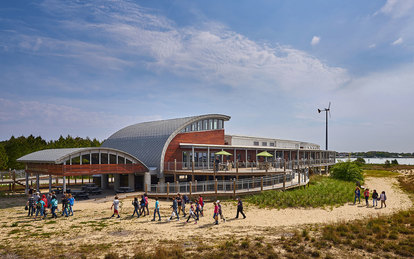SmithGroup-designed Brock Environmental Center certified as one of the Greenest Buildings on the Planet

Building that’s net positive energy and first in U.S permitted to “drink” its rainwater earns Living Building Challenge certification
The Chesapeake Bay Foundation’s Brock Environmental Center, designed by SmithGroup, has taken its place as a new paradigm for sustainability.
The Brock Center has achieved the world’s biggest accolade for environmentally friendly design with earning Living Building Challenge (LBC) certification from the International Living Future Institute. The certification means the building has produced more energy than it used over 12 consecutive months and met a host of other strict criteria for water use, location, health, materials, equity and beauty. To date, there are only 10 other such ultra-sustainable buildings in the world certified by the Living Building Challenge.
The 10,500-square-foot education building pushes the sustainable design envelope hard. Not only has it generated 1.83 times more energy than it used over the past year, but it also treats the rainwater that falls on its roof so it’s drinkable.
“The Brock Center’s performance pushed the boundaries on what is possible. Regenerative, net-positive design is more than an aspiration, it has been achieved,” said SmithGroup project manager and design architect Greg Mella, FAIA, LEED AP BD+C.
The Net-zero energy building generates its own electricity via solar and wind-powered renewable energy and over the past year actually produced 83% more energy than it used. The Brock Center’s 168 rooftop solar panels produce 60 percent of the building’s energy needs by converting the sun’s energy to electricity. Two small, 10-kilowatt wind turbines, 70 feet tall, contribute the remaining 40 percent of the building’s energy needs. The building’s electric bills are $17 each month -- the minimum fee to simply tie into the electrical grid – with the excess energy the Brock Center creates going to Dominion Virginia Power. Hence, the utility will issue the Brock Center its first refund check in November 2016.
An advanced drinking water system has also put the Brock Center in the news for its high sustainability. In 2015, it became the first commercial building in the continental U.S. to be permitted to treat, to federal standards, harvested rainwater for potable uses. The center collects rainwater from its roof and then stores it in tanks located below the elevated first floor. A state-of-the-art water filtration system -- licensed by the State of Virginia’s Office of Drinking Water -- then filters the water for drinking as well as hand-washing. The Brock Center features waterless, composting toilets and all grey water (wastewater generated from sinks and showers) is channeled through an infiltration garden consisting of native plants where natural processes will clean and return it to the underground aquifer.
SmithGroup designed the building to use very little energy by incorporating a series of aggressive, energy-saving features such as natural ventilation, natural daylighting and sunshading, highly efficient geo-thermal heating and cooling, and a highly insulated exterior envelope.
Designed for resiliency, the Brock Center is situated on a coastal site to facilitate the client’s outdoor education program. The design anticipated the onset of sea-level rise and hurricanes: the building is set back 200 feet from the shore and sits on pylons 14 feet above sea level. Even the building’s structural steel system was designed to be capable of resisting 120-mph hurricane force winds.
“Staying closely involved during the Brock’s first year of operation has definitely increased my understanding of green buildings,” added Mella, who co-leads SmithGroup’s firmwide sustainability initiatives. Mella was the recipient of a 2016 Living Building Challenge Hero Award, given to those individuals who have demonstrated exceptional commitment to the Living Building Challenge and whose work has helped to create an ecologically resilient and regenerative built environment.
The Brock Center is located on the Lynnhaven River at Pleasure House Point in Virginia Beach, Virginia. The one-story building was completed in November 2014 for $8 million (which includes all site costs), constructed by Hourigan Construction with Skanska, New York, NY, serving as the owner’s representative. The Center serves as the hub for the Chesapeake Bay Foundation’s Hampton Road office and supports its mission to defend one of the nation’s most valuable and threatened natural resources – the Chesapeake Bay. In addition to offices for the Foundation and partner groups, the building features an 80-seat conference room, meeting rooms, and exhibit display areas. Site development, focused on preservation of the local ecology, includes a boat pier with floating dock, and an open-air education pavilion. The Brock Center's Living Building Challenge Dashboard is a real-time gauge of the building's energy and water use and energy generation.
The Brock Environmental Center is open to the public for tours. Since its grand opening in January 2015, it has welcomed more than 30,000 visitors. The building is the latest Chesapeake Bay Foundation initiative to push the boundaries of sustainability. The Foundation started with the 2000 completion of its Annapolis, Maryland headquarters building, the Philip Merrill Environmental Center, also designed by SmithGroup. In 2001, the Merrill Center became the world’s first LEED Platinum building and quickly became recognized as an international model of sustainability.
For more information about SmithGroup, please visit our Company Fact Sheet.